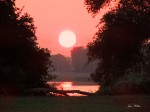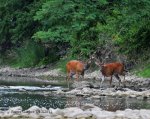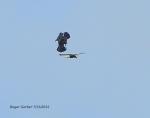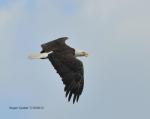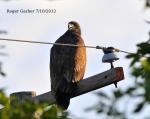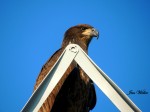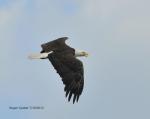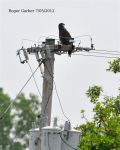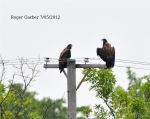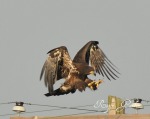-

-
( ) = damaged nest. X = broken off trees.
-

-
The first eaglet that we spotted.
-

-
Cindy in the remains of the nest.
-

-
Jim and his duck.
-

-
Flying skills are improving.
As I had stated in my last posting, after the wicked winds of yesterday’s severe thunderstorms blasted through the area, we were expecting the worst as we made an impromptu late evening visit to the well field. The rapidly failing daylight allowed for only a quick assessment of the damages, but they appeared to be major. We decided to try it again at 6:30 this morning.
We arrived at the nesting site with the early morning sun still struggling to fight its way through the overcast skies. The heavily filtered light revealed the devastation around us. Many large trees had been snapped off about 10 feet above the ground and now looked like slumbering giants in the haze. Others were completely uprooted. One had toppled across some utility lines and was resting squarely on the top of a crushed electrical cabinet. Limbs littered the ground in every direction. The usually clamorous Great Blue Heron Rookery was eerily silent. The large population of noisy Canada Geese were quietly standing in the distance and the Whitetail Deer were nowhere to be seen. The lone bit of active wildlife was a mother Wood Duck and her twelve ducklings skating through a debris-laden pond. I sensed an ominous chill in the air.
As we reached the area of the Bald Eagle nest the first sight that caught my eye was the tops of several sycamore trees strewn into the lagoon just south of the nesting tree, half-submerged but looking like well-gnarled fingers scratching the banks above the water’s surface. Fresh, green leaves were gathered in large floating islands in the neighboring lagoons. As we inspected the damaged sycamores we were encouraged to find the nesting tree still intact, but the trunk of the large sycamore immediately east of the nesting tree was completely severed about 30 feet above the ground and only a jagged, pointed, hollow stump remained. The two sycamore trees just a bit farther east had suffered a similar fate as the storm whipped through the area. Then we saw the aerie itself, or at least what was left of it. Yesterday it had been eight feet wide and five or six feet deep, now it was little more than a heron nest, maybe four feet wide and only a foot or two deep. The violent winds had apparently torn the top wall of the nest off of its foundation and the scattered the remains across the well field as there was no massive pile of sticks to be seen. But what had happened to the eagles?
Our group of five carefully searched the tree limbs for any sign of the five missing birds. We slowly walked the grounds inspecting the tall grass as we passed. Our binoculars systematically scanned the leafy canopy paying special attention to the eagle’s favorite perches that we have become so accustomed to watching. The trees along the Mad River where Jim so often sits and hunts, the large tree that served as Cindy’s favorite guard station and the distant trees across the lagoon where the eagles often seek shady relief from the summer’s heat were all empty of wildlife. This was very unusual for by now it was well pass 7 AM and we knew that the eagles routinely enjoy their breakfast at that hour. As Roger and I began to search the grass along the lagoon behind the nesting tree and the water’s surface for any sign of an injured or dead eagle, we were relieved to spot one lone eaglet sitting high in yet another sycamore tree. He had been watching us as we were searching and now we were watching each other, a mere 70 feet apart. It appeared to be uninjured and during the twenty minutes or so that we studied it and the depths of the nearby trees, it looked rather shell-shocked and fatigued.
I wondered at all that this young one must have experienced during the previous afternoon. The sun-drenched skies had suddenly grown dark and threatening. The still, stale air had instantly exploded into an 80 mile-per-hour gale. The rushing winds were thick with dust, stick, leaves and other projectiles. The hot, muggy weather had gone from 97 degrees to 67 degrees as the storm brought havoc to its world. Its hot, dry feathers were at once waterlogged. And what about the terrible sounds? The deep rumble of the thunder, the crackling of the lightning and the deafening snapping of the massive trees just feet away. How did it stand its ground against the storm’s fury? Talons are strong, but are of no use when the limb or the tree on which you rely for shelter proves unworthy of your faith. Did it know to position a tree trunk between itself and the approaching assault? An eaglet caught up into the air in such a storm is only so much more debris. How had it survived at all?
Shortly after the sun finally began to emerge from the overcast skies, the eaglet flew. We watched as it disappeared into a distant clump of trees. Then, as we turned we saw the unmistakable silhouette of an approaching adult Bald Eagle! It was Jim! He came flying in from somewhere beyond the Mad River and headed toward the eaglet. As he passed overhead we could see that he was not alone for in his talons he carried a rather plump duck. It was indeed breakfast time after all. He disappeared into the same distant clump of trees as the eaglet. Then we noticed yet another eaglet approaching along the same path that Jim had taken. It too passed low overhead and went towards that same clump of trees, but rather than following Jim and its sibling into the trees it attempted to land on a dry, dead limb. That limb cracked beneath the eaglet’s weight and fell to the ground as the surprised eaglet stuttered, then found its wings again and flew to the south. That is when the third eaglet flew into what was left of the nest. As it landed, Jim emerged from the trees and flew back towards the river and the eaglet in the nest soon followed. The eaglet that was forced to abort its landing circled back to the nest but missed its target again and crashed into the small branches just to the south of the nest. It settled awkwardly into the leafy seat as if that was its intent all along. We decided that this must be the youngster that had only fledged three days earlier as it did not display the skill nor the experience of its siblings. As it was trying to get comfortable in its un-eagle-like perch, Cindy arrived at the nest!
That accounted for all five of the eagles! All appeared healthy and were flying well! And not only that, they are still using the “micro-nest” as home. The 2012 nesting season is all but over and soon the eagles will retreat to the seclusion and safety of the east end of the well field. There the eaglets will master their flying skills (and more importantly, their landing skills). Then the fishing and hunting training will take place on the various lakes nearby. I fully expect that late this fall Jim and Cindy will again begin rebuilding the nest and now there is sure to be an ample supply of sticks available for their construction project.
